
Traditional Indian Bread Varieties
In this era of pizza and burger, in India, Indian traditional rotis are still people favorite not only because of roti’s nutritional values and because of the way rotis prepared. Children visit home during weekend for home cooked food and love to eat food prepared by grandmother or mother. That thought of having (varieties) hot rotis from the tava served with fresh butter and curry brings back fond memories of family and home for all !
In India, bread means rotis, naan, chapati or paratha varieties. The variation in Indian bread depends on the climate and region. Each type of roti has its own unique property and nutritional value. Preparation method of various varieties of rotis also different and needs certain skills. In India, bread is eaten more in the northern regions of the country because of its dry climate. There are a variety of breads consumed in India like roti, naan and paratha. Indian roti is flat and cooked on a tava or cast-iron griddle. It can also be cooked in a tandoor. Roti is thin and made of atta (wholewheat). The naan is soft and fluffy and is made from plain flour with a little bit of yeast. Parathas are layered bread made of wheat flour but fried in little oil. The breads are prepared according to one’s own taste and imagination. That is why in India we have variety of breads like the plain naan, garlic naan, methi roti, aloo paratha, puri, bhature etc
CHAPATI: Click here to read more
The word chapat (चपत) in Hindi means “to slap”, and the traditional method of forming rounds of thin dough is by slapping the dough between the wetted palms of the hands. With each slap, the round of dough is rotated. Ayurveda dates it back to the Vedic period – where purodhashas, from where the word pataha or parota eventually came, was usually stuffed with dry lentils or vegetables and offered as thick pancakes during yagnas and homas in Indian tradition – there is little mention of the humble chapati. Available literature on chapati is noted in Ain-i-Akbari, a 16th-century document by Mughal Emperor, Akbar’s vizier, Abu’l-Fazl ibn Mubarak as one of the Great Emperor’s favourite.
A dough is prepared with atta and water, kneaded with the knuckles of the hand made into a fist and left to prove for at least ten to fifteen minutes for the gluten in the dough to develop. After proving, the dough becomes softer and more pliable. Small portions of the dough are pinched off and formed into round balls that are pressed between the two palms to form discs which are then dipped into flour and rolled out on a circular rolling board (chakla) using a rolling pin (velan or belan) into a perfect circle. The belan is formed differently according to region. The rolled-out dough is then thrown on the preheated dry tava (griddle) and cooked on both sides.
An interesting story about popularity of chapathi is in our history. It dates back to 1574 when Bikrmi Shri Guru Nanak Dev ji reached Manikaran with his two disciples Bala and Mardana. After days of walking, Mardana began to starve, but with no source to cook meals he had abandoned the idea till Guru Nanak asked him to lift the stone and find hot water spring underneath. He then instructed his disciple to roll out chapatis in the spring. But to Mardana’s despair the chapatis drowned. And then a few minutes later they appeared on the surface, perfectly baked. Since then it is believed that anything you put in the Hot Spring will float. Many believe that this may have been the first puri as well.
Image Courtesy: http://entouraaj.com/wp-content/uploads/2012/11/Chapatis.jpg
PHULKA: Click here to read more
In some regions of Nepal and Western India they are only partly cooked on the skillet, and then put directly on a high flame, which makes them blow up like a balloon. The hot air cooks the chapati rapidly from the inside. This is commonly called Phulka. Phulka is smaller round prepared from wheat flour but is rolled first, then one side is cooked on a pan(Tava) and the other side directly on heat.
TANDOORI ROTI: Click here to read more
The word roti is derived from the Sanskrit word रोटिका (roṭikā), meaning “bread”. Tandoori roti is a very popular bread which is made from whole wheat flour and made in a clay oven commonly known as tandoor. Tandoori roti is considered to be healthy food than naan. It contains whole wheat flour/ atta, little baking powder, yogurt, salt and water. There is no oil, butter or ghee added. It is a dry roti.
Naan is one of the most popular flat breads served with South Asian food. In particular, accompanying food from the Northern Area of India, Pakistan, Afghanistan, Bangladesh, Iran, Uzbekistan, Tajizkistan and surrounding areas. Originally from Middle Eastern countries, naan occupied hearts of Punjabis, India. The first recorded history of Naan can be found in the notes of the Indo-Persian poet Amir Kushrau in 1300 AD. Naan was originally cooked at the Imperial Court in Delhi as naan-e-tunuk (light bread) and naan-e-tanuri (cooked in a tandoor oven). During the Mughal era in India from around 1526, Naan accompanied by keema or kebab was a popular breakfast food of the royals. The word Naan is derived from the Persian word ‘non’ which refers to bread, and initially appeared in English Literature dating back to 1780 in a travelogue of William Tooke. In 1926, overlooking the hustle and bustle of Regent Street, Veeraswamy, Britain’s oldest Indian restaurant served Naan on its menu. A typical naan recipe involves mixing All purpose flour with salt, a yeast culture, and enough yogurt to make a smooth, elastic dough. The dough is kneaded for a few minutes, then set aside to rise for a few hours. Once risen, the dough is divided into balls, which are flattened and cooked.
The ‘World’s Biggest Naan Bread’ was made in 2004 by Honeytop Specialty Foods. The Naan measured exactly 10ft by 4ft and celebrated the launch of Brewers Fayre’s Curry Nights in the UK. It took over five hours to make and required eight staff to carry it! Varieties of Naan that are available are garlic, onion etc.
Image courtesy: https://encrypted-tbn0.gstatic.com/images
BHAKHRI: Click here to read more
Bhakhri is gluten free Indian flat bread which is common in Maharashtra, Gujarat, Goa and Rajasthan. It can be made with bajra (pearl millet) flour, ragi (finger millet) flour, sorghum (jowar) flour, wheat flour or rice flour. Most of these flours are gluten free and hence requires some practice to make. These flours are also high in dietery fiber and hence makes it a healthy meal. Bhakhri contains pearl millet, salt and water. Bhakhri is typically biscuit-like bread flavored with ghee and cumin seeds. Generally, there are two types of bhakhris—one is cooked like a biscuit while the other is puffed up and served with ghee.
Image Courtesy: http://www.foodandcuisine.com/img/recipes/11/bajra-bhakri-recipe.jpg
PARATHA: Click here to read more
A paratha is a flatbread that originated in the north of the Indian Subcontinent. Parathas originated in Peshawar and then spread all over the former northern parts of India. It began as a wholesome meal often eaten at breakfast. The paratha is stuffed unleavened bread with various fillings that could be added according to your choice. It is still quite prevalent in the north of India, where wheat is grown and is the traditional staple of the area. Paratha is an amalgamation of the words parat and atta which literally means layers of cooked dough. There are number of varieties of parathas – Plain paratha with no stuffing but smeared with butter and ghee, Aloo paratha -popular variety with stuffed potato with little or no spice, gobi paratha -stuffed with cauliflower, methi paratha – flour mixed with fenugreek and cumin powder, cabbage paratha – stuffed with cabbage, mixed vegetable paratha, laccha paratha – contains few layers inside and round or triangle in shape, palak paratha, raddish or mooli paratha, tomato paratha and there are few non vegetarian parathas that are popular too.
Image courtesy: http://vinovisione.com/wp-content/uploads/2015/01/Aloo-Paratha.jpg
PAROTTA: Click here to read more
Regardless of its origins, parathas soon became popular all over South Asia. All south Indian states have their own versions of the ubiquitous paratha, the most popular being “Kerala Porotta,” which is mostly made of ‘maida'(white flour) instead of ‘atta'(wheat flour). The Kerala Porotta is popular and is usually devoured with egg roast, chutney, yogurt, avial and non vegetarian curries
Image courtesy: http://kingofkeralaparadise.com/wp-content/uploads/2015/07/Kerala-Porotta.jpg
AKKI ROTTI: Click here to read more
If you visit Bengaluru city of Karnataka city, often you will find boards saying ” Akki and raagi rotti is avaialble for lunch or breakfast” In many households it is a week end special.
Akki Rotti is a rice-based breakfast item unique to the state of Karnataka, India but extremely popular. Akki-Rotti means rice-bread in the native language, Kannada. It is made of rice flour which is mixed with salt and water and kneaded well to make a soft dough. Sliced onions and chilies, curry leaves, chopped coriander and cumin seeds are added while kneading the dough. Oil is spread over a griddle (tava and a small amount of the dough is stretched to a thin sheet to cover the entire griddle (rotti). A small amount of oil is spread over it and the griddle is placed over heat till the rotti turns golden brown. Akki Rotti is served hot and is eaten along with chutney. A dash of fresh butter or ghee with Akki Rotti is also preferred. In some parts along with butter, ghee people use molasses and coconut chutney on side for the taste. Traditionally women use banana leaves to spread akki rotti and will transfer to a tava on a clay oven.
Image courtesy: http://1.bp.blogspot.com/-a01UcZqAXmo/U6R63a02tnI
RAGI ROTTI: Click here to read more
Another popular breakfast food from Karnataka, India. This is very nutrient rich, less in calorie. Made of finger millet flour this rotti supplies calcium, fiber, iron and is gluten free too. Ragi boosts lactation, good for babies and increases blood cells.
It is most popular in the rural areas of southern Karnataka. It is made of ragi (finger millet) flour. Ragi-Rotti means ragi-pancake in the native language, Kannada. It is prepared in the same way as Akki rotti. The ragi flour is mixed with salt and water and kneaded well to come up with a soft dough. While making the dough; sliced onions, chopped coriander, chillis and cumin seeds can also be added for taste. Oil is spread over a griddle (tava) and a small amount of the dough is neatly spread over it to resemble a thin pancake (rotti). Small amount of oil is spread over it and the griddle is cooked over heat till the rotti turns crisp. Ragi Rotti is served hot and is eaten along with cocount, garlic chutney.
Image courtesy: http://www.itslife.in/wp-content/gallery/receipe-breakfast/
JOWAR ROTTI: Click here to read more
The very humble Jolad rotti or Jowar rotti is a must in any North Karnataka(Hubli, Dharwad, Belgaum, Gokak, Bijapur) Women from Northern Karnataka are much familiar and expert in making this type of rotti. A lot of experience and nack is required in making these in the traditional way. Main ingredient here is sorghum. This bread doesn’t need any resting time as many other indian breads, moreover it is gluten free. Fiber, calcium, protein and loads of energy come together in a tasty roti flavored with spring onions and green chillies. Apart from gluten-free it is also very less in cholesterol. The dough is prepared by mixing the jowar flour with hot water and then the roti/rotti is spread using the palm.
MAKKI KI ROTI: Click here to read more
Bread of corn or Makki di roti, मक्की दी रोटी (Sanskrit) is a flat, unleavened Punjabi bread made from corn flour, primarily eaten in Punjab region of India and Pakistan. Like most rotis in South Asian cuisine, it is baked on a tava. It is an important element of the rural Punjabi cuisine. It is made from corn flour and cooked on griddle and topped with butter. Makki di roti is yellow in color when ready, and has much less adhesive strength — which makes it difficult to handle. Due to this, making makki di roti is more difficult than roti made from wheat flour. Makki di roti is generally made during winter in Punjab and is perhaps best known when accompanied with saag (especially sarson da saag i.e. cooked mustard green leaves), Similarly, in Uttar Pradesh, it is eaten with spinach and added butter. Typically, the flour is kneaded with cold water in India, but if made at home in an English kitchen, then hot water from a kettle is used. Makki di roti accompanied with butter and buttermilk is very popular combination in Punjab. Makki ki roti is generally made during the winter months in Punjab. Traditionally ladies make Makai ki roti by hand and roast over kanda (cow dung cakes) on chulha (open fire stove) that gives this roti a smoked flavor and serve with homemade butter. These days everybody use rolling pin to roll roti and cook on tava (griddle). Corn flour has less adhesive strength which makes it difficult to make roti than wheat flour. This is one of the reasons to mix wheat flour with corn flour to make roti.
Image Courtesy: http://i.ytimg.com/vi/mceH1VrWo8U/maxresdefault.jpg
POORI & BATHURA: Click here to read more
PURI
Poori or puri, is an unleavened deep-fried Indian bread, commonly consumed on the Indian subcontinent. It is eaten for breakfast or as a snack or light meal. It is usually served with a curry or bhaji, as in Puri bhaji. The name puri derives from the Sanskrit word पूरिका (pūrikā), from पुर (pura) “filled” Puri is prepared with wheat flour, either atta (whole wheat flour), maida (refined wheat flour), or sooji (coarse wheat flour). Maida flour is the most common flour used in making Puris. In some recipes, cumin seed are also added to the dough. A dough of flour and salt is either rolled out in a small circle or rolled out and cut out in small circles and deep fried in ghee or vegetable oil. While deep frying, it puffs up like a round ball because moisture in the dough changes into steam which expands in all directions. When it is golden-brown in color, it is removed and may be served hot with spicy potato curry or mixed vegetable kootu or chickpea curry.
BHATURA
Another popular breakfast or evening dish is Bhatura or chenna bhatura. Bhatura is similar to poori and usually served with chenna masala or chickpea gravy. It is a specialty of State of Punjab, India.
A typical recipe includes white flour (maida), yogurt, ghee or oil, and either yeast or baking powder. Once kneaded well, the dough is left to rise, and then small balls of it are either hand-rolled or flattened using a rolling pin. Then the bread pieces are deep fried until they puff up into a lightly browned, soft, fluffy bread, which is elastic and chewy. The dish is available in almost all eating-places in both south and north India and also on street vendors. The dish can also be prepared at home in a healthier and less-oily manner and also the bhature can be made filled with potato, cottage cheese etc. the dish is considered for a heavy breakfast, Chole Bhature is a great treat for college students who enjoy this delicious dish greatly.
Image Courtesy: https://upload.wikimedia.org/wikipedia/commons/9/97/Bhatura.jpg
References:
Author: Sumana Rao | Posted on: October 9, 2015


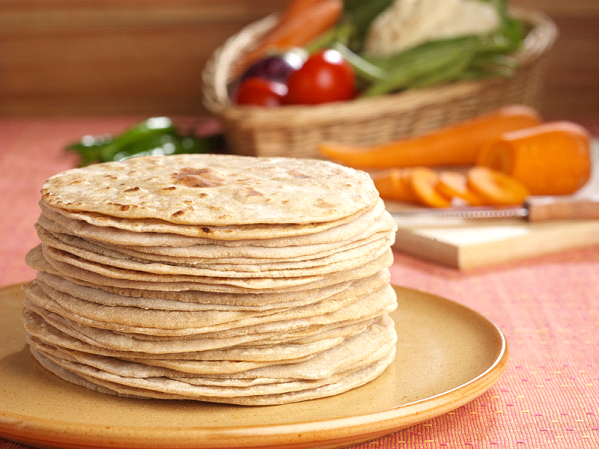

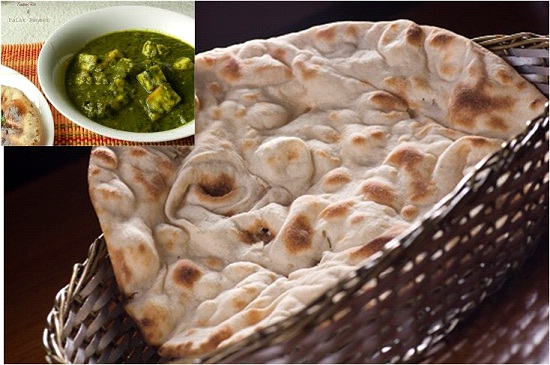
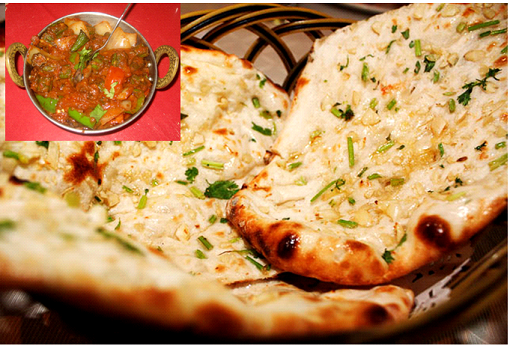
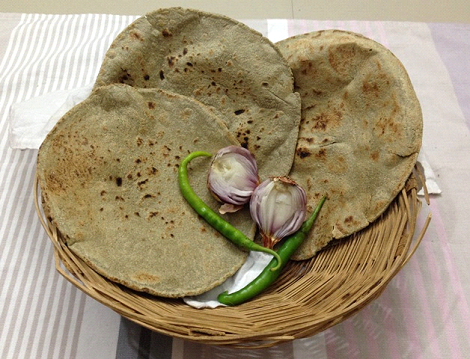
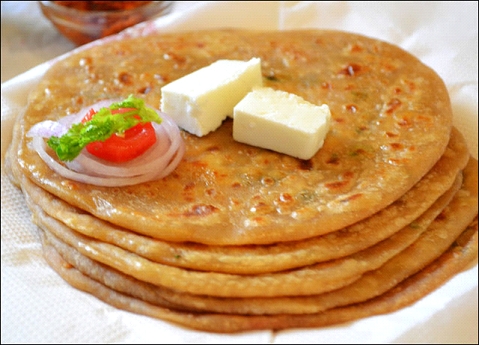

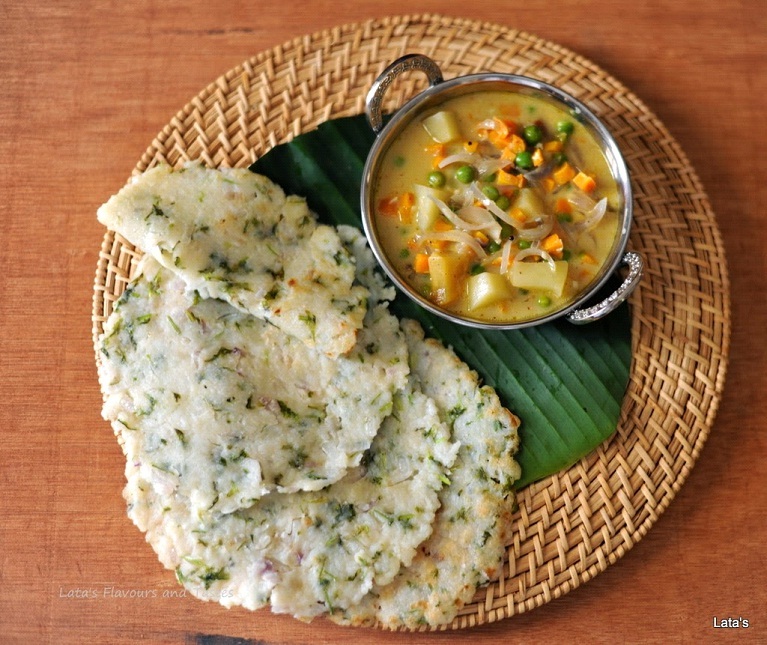

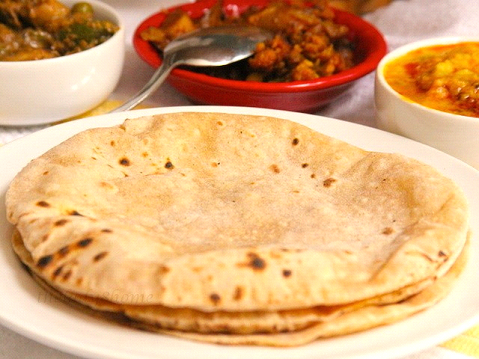
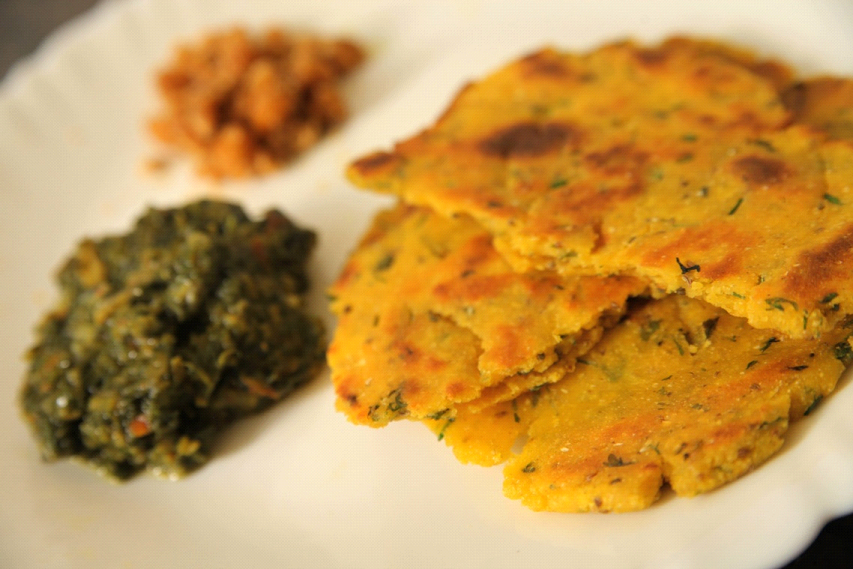
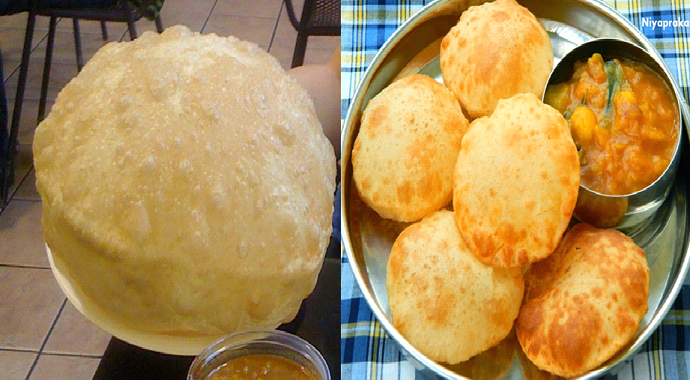

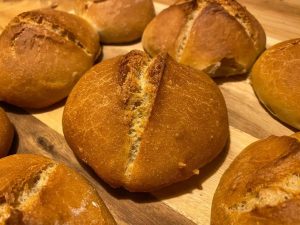
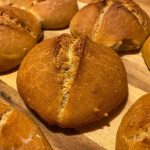












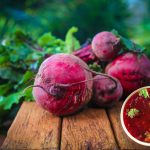




Write a comment